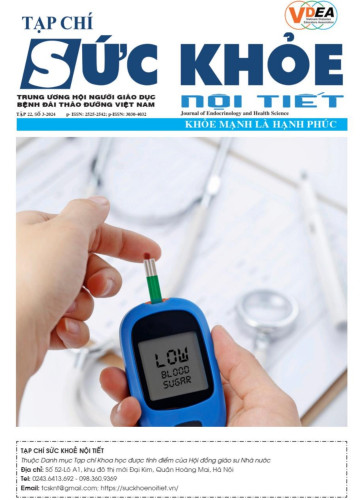Đăng ký
Vui lòng nhập các thông tin cần thiết

TÀI LIỆU THAM KHẢO
1. Phạm Thị Minh Đức ( 2001). Sinh lý sinh sản nữ, Sinh lý học tập 2, Bộ môn sinh lý học- Đại học Y Hà nội. Nhà XBYH, tr 135-151.
2. Nguyễn Khắc Liêu ( 2002). Sinh lý sự mãn kinh, Sản phụ khoa tập 2. Bộ môn Sản , Đại học Y Hà nội. Nhà xuất bản Yhọc, tr 225-267.
3. Thienpont L; Verhseghe P.G; Van Brusel K.A. De Leenheer A.P. (1998). Estradiol-17B- quantified in serum by isotope delution- Gas chromatography- Mass spectrometry, Chinchem ( 34); 10: 2006-2009.
4. World health organization( 1996). report of a WHO scientific group: Research on Menopause in 1990-1993.
5. Kim, C., & Halter, J. B. (2013). The Endocrine Effects of Aging on Glucose Metabolism. The Journal of Clinical Endocrinology & Metabolism, 98(2), 447-453.
6. Carr, M. C. (2003). The Emergence of the Metabolic Syndrome with Menopause. The Journal of Clinical Endocrinology & Metabolism, 88(6), 2404-2411.
7. Lindheim, S. R., Buchanan, T. A., & Duffy, D. M. (1994). Effects of Physiologic Ovarian Steroids on Glucose Tolerance in Postmenopausal Women. The Journal of Clinical Endocrinology & Metabolism, 79(2), 340-344.
8. Lovejoy, J. C., Champagne, C. M., de Jonge, L., Xie, H., & Smith, S. R. (2008). Increased Visceral Fat and Decreased Energy Expenditure during the Menopausal Transition. International Journal of Obesity, 32(6), 949-958.
9. Im, J., & Baek, W. K. (2019). Menopause and Changes in Blood Glucose. Journal of Menopausal Medicine, 25(2), 94-98.
10. Ma, R. C. W., & Chan, J. C. N. (2013). Type 2 Diabetes in East Asians: Similarities and Differences with Populations in Europe and the United States. Annals of the New York Academy of Sciences, 1281(1), 64-91.
11. Gurka, M. J., Vishnu, A., Santen, R. J., & DeBoer, M. D. (2016). Progression of Metabolic Syndrome Severity during the Menopausal Transition. The Journal of Clinical Endocrinology & Metabolism, 101(11), 4251-4259.
12. Kautzky-Willer, A., Harreiter, J., & Pacini, G. (2016). Sex and Gender Differences in Risk, Pathophysiology and Complications of Type 2 Diabetes Mellitus. Endocrine Reviews, 37(3), 278-316.
13. Mauvais-Jarvis, F., Clegg, D. J., & Hevener, A. L. (2013). The Role of Estrogens in Control of Energy Balance and Glucose Homeostasis. Endocrine Reviews, 34(3), 309-338.
TÓM TẮT
Mục tiêu: nhằm làm rõ tỷ lệ bệnh đái tháo đường, rối loạn đường huyết lúc đói, rối loạn dung nạp glucose ở phụ nữ lứa tuổi quanh mạn kinh. Phương pháp và kết quả: Kết quả nghiên cứu điều tra cắt ngang cho thấy tỷ lệ đái tháo đường: 3,77%, tiền đái tháo đường 46,71%. Các hormon giới tính ở người bệnh đái tháo đường đều bị suy giảm có ý nghĩa so với nhóm người khỏe mạnh. Ví dụ, nồng độ Estradiol giảm là 78,57%, nồng độ Progesteron ở mức giảm là 62,5%. Sự khác biệt có ý nghĩa thống kê với p<0,01. Trong nhóm “ tiền đái tháo đường” tỷ lệ người có Progesteron ở mức giảm cao hơn so với nhóm chứng (20,69%) có ý nghĩa thống kê với p<0,01. Tỷ lệ người bệnh đái tháo đường có FSH ở mức tăng là 100%, cao hơn so với nhóm chứng (82,24%) có ý nghĩa thống kê với p< 0,001. Kết luận: Nghiên cứu cho thấy tỷ lệ đái tháo đường và tiền đái tháo đường ở phụ nữ quanh mãn kinh cao, kèm suy giảm các hormon giới tính như Estradiol và Progesteron. Những thay đổi hormon này có thể ảnh hưởng đến rối loạn chuyển hóa glucose, do đó việc theo dõi hormon giới tính giúp hỗ trợ chẩn đoán và quản lý bệnh lý chuyển hóa
Từ khóa: đái tháo đường, quanh mạn kinh, hormon
CHANGES IN GLUCOSE METABOLISM AND RELATED FACTORS IN PERIMENOPAUSE WOMEN
ABSTRACTS
Objective: The prevalence of diabetes, Impaired Fasting Glucose, and Impaired Glucose Tolerance in perimenopausal women is rather high. Methods and Results: and Namely, the prevalence of diabetes is 3,77%, pre-diabetes is 46,71%. The sexual hormones in patients with diabetes are significantly decreased compared with normal people. For instance, the rate of decreased Estradiol level was 78,57%, the rate of decreased progesterone level was 62,5%, there is a significant difference with p<0,01. In the pre-diabetes group, the rate of decreased progesterone level was significantly higher than the control group (20,69%) with p< 0,01. In diabetes patients, the rate of increased FSH level was 100%, significantly higher than the control group (82,24%) with p < 0,001. Conclusion: The study showed a high prevalence of diabetes and prediabetes in perimenopausal women, accompanied by a decline in sex hormones such as Estradiol and Progesterone. These hormonal changes can affect glucose metabolism disorders, so monitoring sex hormones helps to support the diagnosis and management of metabolic diseases.
Keywords: diabetes, perimenopause, hormone